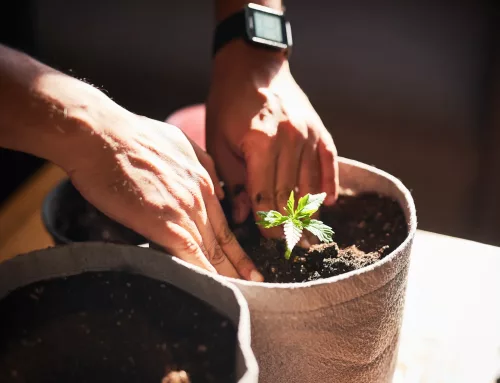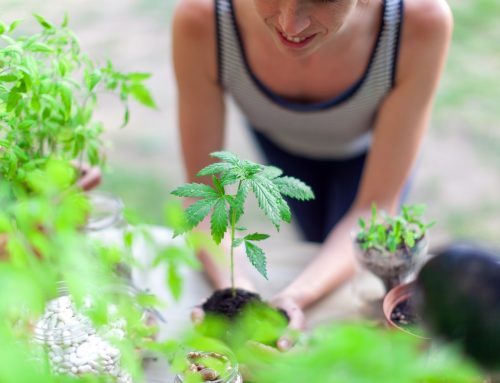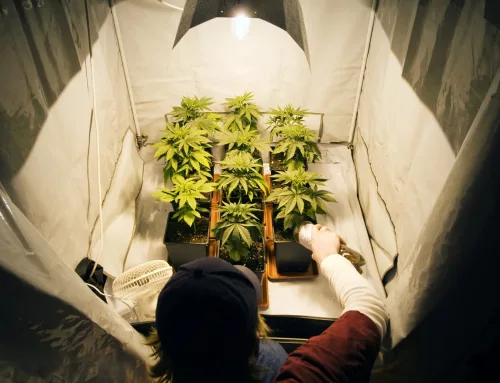One of the most common mistakes growers make is overwatering their cannabis plants.
Overwatering can critically impact the health and productivity of your cannabis plants, leading to a host of issues that can compromise plant health. Even if you’re following a schedule, every plant feeds differently, which is why you need to be able to recognize signs of water stress and know how to fix overwatered cannabis plants.
This article will help you do just that, with common signs of stress, step-by-step guidance on how to rescue and restore overwatered cannabis plants, and tips for avoiding the issue in the future.
Recognizing the Signs of Water Stress
If you don’t know what it looks like when you’re overwatering cannabis plants, it can be hard to know if you’re overdoing it.
Your plants will tell you when they’ve had enough, and the earlier you notice and adjust feeds, the better chance you’ll have of preventing long-term damage to your cannabis plants.
4 Telltale Signs of Overwatered Cannabis Plants
- Saturated Soil: One of the most obvious signs your plant is overwatered and a victim of water stress is if the soil appears waterlogged and never seems to dry out.
If your soil feels soggy to the touch, your plant has enough water (for now), and adding more could deprive it of oxygen.
Check back later after allowing the soil to dry down to encourage roots to search for moisture and develop a healthy root base. - Droopy Plants: In addition to the soil remaining wet, overwatered plants will often appear wilted or droopy.
This is because the roots are suffocating and unable to function properly, leading to an inability to support itself. Allowing the soil to dry out should help the plant perk back up. - Cannabis Clawing: This term describes leaves that curl down, resembling a claw.
This symptom is a result of the roots’ inability to access oxygen and properly absorb nutrients. Clawing is an early sign of overwatering to watch out for, and is a hint to scale feeds back. - Fungus Gnats and Visible Pests: Visible pests in and around your soil are an almost surefire sign you’ve overwatered.
Moist environments attract pests like fungus gnats, which thrive in wet soil, eating the decaying roots as they die from suffocation. As you can see, problems in the root zone compound quickly.
Not only do they create a pest management problem for you, but their presence can also add to the stress your plants are experiencing, damaging roots further and spreading root-borne diseases like Pythium.
Pests can be a challenge when dealing with an overwatered plant as you don’t want to add more moisture to the mix. Drydowns and passive IPM tools like sticky traps will be your friend until your soil dries out.
First, you need to get your soil dry, then you can implement pest management protocols during your feeds to address the bug problem.
If you notice any of these signs, take note and adjust your feeds accordingly, delaying them or decreasing the volume per feed.
What Not to Do When Fixing Overwatered Cannabis Plants
When it comes to home remedies, there’s no shortage of wacky tricks us growers will come up with (and recommend). Don’t trust everything you read, as they say.
Once you discover that your cannabis plants are overwatered, there are a few things you DON’T want to do because they can make things worse:
- Heat Guns & Hair Dryers: While it might seem like a quick fix to dry your soil, using a hairdryer or heat gun can harm the plants’ roots.
Gradual, uniform warming that slowly encourages evaporation is much better than targeted, intense heat that can damage the roots and melt plant containers depending on the material they are made out of. - Tight Schedule: Overwatered plants need a break from watering to recover, regardless of what your feed schedule says.
Continuing to water them according to a preset schedule will only prolong the saturation and delay recovery. - Radical Overcompensation: It’s a natural reaction to want to fix things fast, and turning up the heat and drying the grow out seem like easy shortcuts to fixing overwatered cannabis plants.
But increasing light intensity or drastically changing ventilation settings to dry out the environment can stress the plants further. Make sure that any changes you make are gradual and controlled.
3 Steps to Fixing Overwatered Cannabis Plants
Follow these practical steps to help your overwatered cannabis plants recover:
1. Cease Watering
- Immediate Action: Stop watering the plants immediately and allow the top inch of the soil to dry out completely before even considering adding more water.
2. Adjust Environmental Conditions
- Temperature and Humidity: Slightly increase the ambient temperature and reduce humidity to help evaporate excess moisture. Use a hygrometer to monitor these conditions accurately. Small changes make a big impact; you don’t have to crank it up to 100ºF to encourage a dry down.
- Encourage Drainage with Risers: Elevate your pots off the saucers or trays they’re in using risers. This prevents water from pooling at the bottom of the containers, ensuring better drainage and helps prevent root rot.
- Direct Fans at Pots: Set up fans on the floor of your grow to circulate air around the pots, rather than directly at the foliage. This helps encourage airflow below the canopy without adding wind stress to your plants from direct airflow.
3. Restore Root Health
- Trim Damaged Roots: Look at the bottom holes of your pots and gently trim away any visibly rotten or mushy roots. Healthy roots are typically white and firm, while damaged roots are brown and soft.
- Sterilize Root Zone: Depending on how long your plants have been overwatered, root-borne pathogens may have found their way into your root zone and need to be treated to avoid latent threats becoming active problems down the road. There are plenty of great products out there to help with this, but make sure that you read the label to ensure the product can safely be applied to the root zone.
- Repot if Necessary: For severe cases, consider repotting your plant into fresh, lightly moistened soil. This can give your plant a fresh start away from the anaerobic conditions of overwatered soil.
Preventative Measures: 6 Tips for Avoiding Cannabis Plant Overwatering
“An ounce of prevention is worth a pound of cure.” It’s often easier to avoid the problem of cannabis overwatering entirely. Here’s a few tips:
- Under Water: If you’re new to growing, or growing a new strain, you may be following a schedule for watering cannabis plants. Always default to under watering or the lowest recommendation. You can always add more water, but it’s harder to remove it once you’ve fed.
- Use a Moisture Meter (or your finger): There are plenty of tools out there to measure the water levels of your soil, though you can also use the ol’ “index finger in the soil trick,” to check to see if the top inch of the soil is dry. If you notice your soil is having a harder time drying down, adjust the frequency and volume of feeds as needed.
- Appropriate Drainage: As mentioned, risers are a great option for lifting pots off of the ground and encouraging proper drainage so that roots don’t sit in stagnant runoff water. It’s important to allow your plants to drain excess feeds as needed.
- Fabric & Vented Pots: If you struggle with overwatering, or are worried about it and trying to prevent an issue before it happens, fabric pots are an excellent tool for helping maintain root health and static moisture levels. If you prefer something a bit more durable, plastic pots with air vents will also help encourage dry downs.
- Aerated Soil Mixes: Soil mixes that are aerated with ingredients like vermiculite, perlite, and rice husks can help ensure your roots have good drainage. If you have a soil mix that does not have these ingredients, you can mix them in on your own, varying proportions and ratios as desired.
- Monitor Plant Response: Last but not least: pay attention to your plants. What are they telling you? Are they asking for more water, barely lasting until your next feed? Then it’s likely time to bump those feeds up. Are they still soggy when you return days later? Might be best to let them dry out, and scale back feeds until they bounce back. When in doubt, refer to the signs of water stress above.
Prevention is the best strategy when it comes to overwatering
Learning to read the needs of your cannabis plants will help you maintain optimal moisture levels. If overwatering occurs, quick and careful action following the guidelines above can help mitigate damage and restore your plants to health.
Remember, more water isn’t always better when it comes to watering cannabis plants.
READY TO GROW YOUR OWN CANNABIS?
Explore Feminized Autoflower and Photoperiod Seeds today!




